Hugo Proença
ZQBA: Zero Query Black-box Adversarial Attack
Oct 01, 2025Abstract:Current black-box adversarial attacks either require multiple queries or diffusion models to produce adversarial samples that can impair the target model performance. However, these methods require training a surrogate loss or diffusion models to produce adversarial samples, which limits their applicability in real-world settings. Thus, we propose a Zero Query Black-box Adversarial (ZQBA) attack that exploits the representations of Deep Neural Networks (DNNs) to fool other networks. Instead of requiring thousands of queries to produce deceiving adversarial samples, we use the feature maps obtained from a DNN and add them to clean images to impair the classification of a target model. The results suggest that ZQBA can transfer the adversarial samples to different models and across various datasets, namely CIFAR and Tiny ImageNet. The experiments also show that ZQBA is more effective than state-of-the-art black-box attacks with a single query, while maintaining the imperceptibility of perturbations, evaluated both quantitatively (SSIM) and qualitatively, emphasizing the vulnerabilities of employing DNNs in real-world contexts. All the source code is available at https://github.com/Joana-Cabral/ZQBA.
Causality and "In-the-Wild" Video-Based Person Re-ID: A Survey
May 28, 2025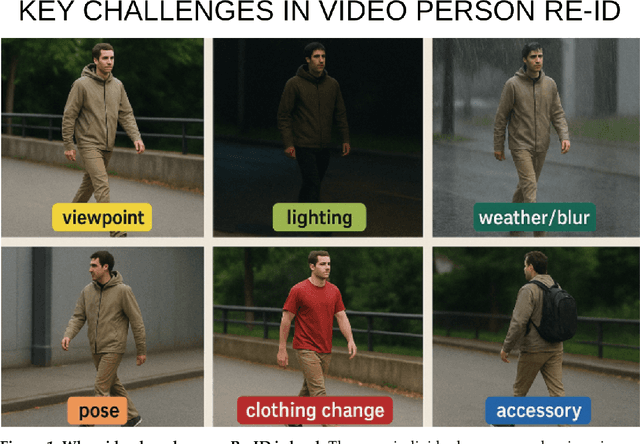
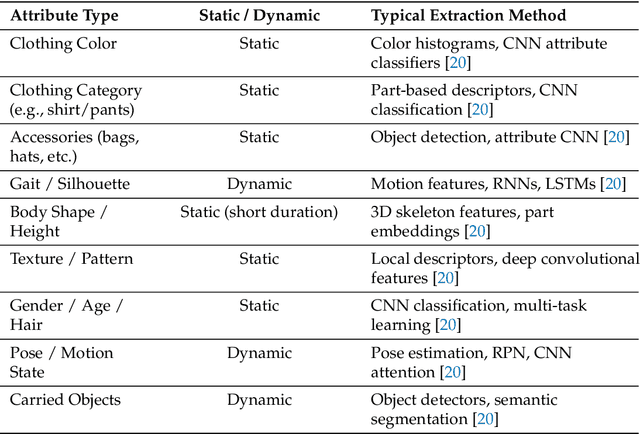
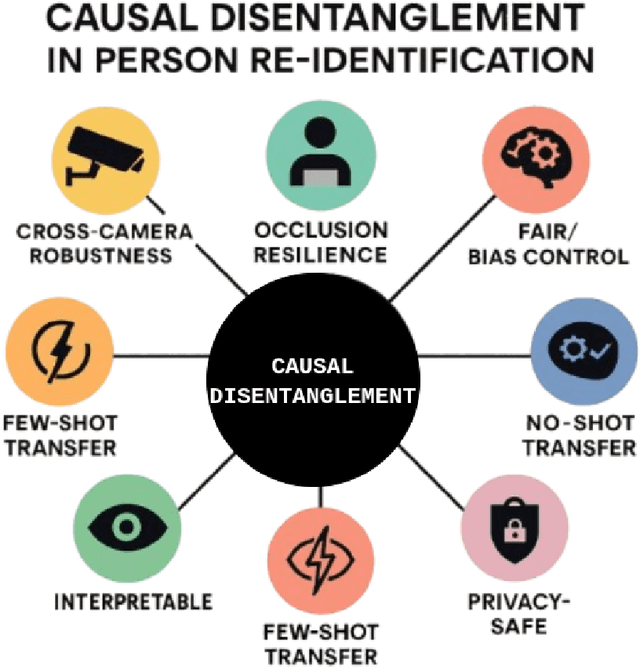
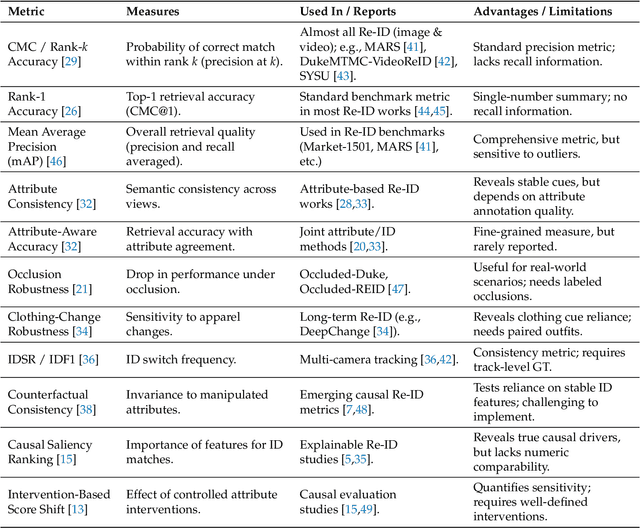
Abstract:Video-based person re-identification (Re-ID) remains brittle in real-world deployments despite impressive benchmark performance. Most existing models rely on superficial correlations such as clothing, background, or lighting that fail to generalize across domains, viewpoints, and temporal variations. This survey examines the emerging role of causal reasoning as a principled alternative to traditional correlation-based approaches in video-based Re-ID. We provide a structured and critical analysis of methods that leverage structural causal models, interventions, and counterfactual reasoning to isolate identity-specific features from confounding factors. The survey is organized around a novel taxonomy of causal Re-ID methods that spans generative disentanglement, domain-invariant modeling, and causal transformers. We review current evaluation metrics and introduce causal-specific robustness measures. In addition, we assess practical challenges of scalability, fairness, interpretability, and privacy that must be addressed for real-world adoption. Finally, we identify open problems and outline future research directions that integrate causal modeling with efficient architectures and self-supervised learning. This survey aims to establish a coherent foundation for causal video-based person Re-ID and to catalyze the next phase of research in this rapidly evolving domain.
DetReIDX: A Stress-Test Dataset for Real-World UAV-Based Person Recognition
May 07, 2025Abstract:Person reidentification (ReID) technology has been considered to perform relatively well under controlled, ground-level conditions, but it breaks down when deployed in challenging real-world settings. Evidently, this is due to extreme data variability factors such as resolution, viewpoint changes, scale variations, occlusions, and appearance shifts from clothing or session drifts. Moreover, the publicly available data sets do not realistically incorporate such kinds and magnitudes of variability, which limits the progress of this technology. This paper introduces DetReIDX, a large-scale aerial-ground person dataset, that was explicitly designed as a stress test to ReID under real-world conditions. DetReIDX is a multi-session set that includes over 13 million bounding boxes from 509 identities, collected in seven university campuses from three continents, with drone altitudes between 5.8 and 120 meters. More important, as a key novelty, DetReIDX subjects were recorded in (at least) two sessions on different days, with changes in clothing, daylight and location, making it suitable to actually evaluate long-term person ReID. Plus, data were annotated from 16 soft biometric attributes and multitask labels for detection, tracking, ReID, and action recognition. In order to provide empirical evidence of DetReIDX usefulness, we considered the specific tasks of human detection and ReID, where SOTA methods catastrophically degrade performance (up to 80% in detection accuracy and over 70% in Rank-1 ReID) when exposed to DetReIDXs conditions. The dataset, annotations, and official evaluation protocols are publicly available at https://www.it.ubi.pt/DetReIDX/
LISArD: Learning Image Similarity to Defend Against Gray-box Adversarial Attacks
Feb 27, 2025Abstract:State-of-the-art defense mechanisms are typically evaluated in the context of white-box attacks, which is not realistic, as it assumes the attacker can access the gradients of the target network. To protect against this scenario, Adversarial Training (AT) and Adversarial Distillation (AD) include adversarial examples during the training phase, and Adversarial Purification uses a generative model to reconstruct all the images given to the classifier. This paper considers an even more realistic evaluation scenario: gray-box attacks, which assume that the attacker knows the architecture and the dataset used to train the target network, but cannot access its gradients. We provide empirical evidence that models are vulnerable to gray-box attacks and propose LISArD, a defense mechanism that does not increase computational and temporal costs but provides robustness against gray-box and white-box attacks without including AT. Our method approximates a cross-correlation matrix, created with the embeddings of perturbed and clean images, to a diagonal matrix while simultaneously conducting classification learning. Our results show that LISArD can effectively protect against gray-box attacks, can be used in multiple architectures, and carries over its resilience to the white-box scenario. Also, state-of-the-art AD models underperform greatly when removing AT and/or moving to gray-box settings, highlighting the lack of robustness from existing approaches to perform in various conditions (aside from white-box settings). All the source code is available at https://github.com/Joana-Cabral/LISArD.
Human Re-ID Meets LVLMs: What can we expect?
Jan 30, 2025



Abstract:Large vision-language models (LVLMs) have been regarded as a breakthrough advance in an astoundingly variety of tasks, from content generation to virtual assistants and multimodal search or retrieval. However, for many of these applications, the performance of these methods has been widely criticized, particularly when compared with state-of-the-art methods and technologies in each specific domain. In this work, we compare the performance of the leading large vision-language models in the human re-identification task, using as baseline the performance attained by state-of-the-art AI models specifically designed for this problem. We compare the results due to ChatGPT-4o, Gemini-2.0-Flash, Claude 3.5 Sonnet, and Qwen-VL-Max to a baseline ReID PersonViT model, using the well-known Market1501 dataset. Our evaluation pipeline includes the dataset curation, prompt engineering, and metric selection to assess the models' performance. Results are analyzed from many different perspectives: similarity scores, classification accuracy, and classification metrics, including precision, recall, F1 score, and area under curve (AUC). Our results confirm the strengths of LVLMs, but also their severe limitations that often lead to catastrophic answers and should be the scope of further research. As a concluding remark, we speculate about some further research that should fuse traditional and LVLMs to combine the strengths from both families of techniques and achieve solid improvements in performance.
ASDnB: Merging Face with Body Cues For Robust Active Speaker Detection
Dec 11, 2024



Abstract:State-of-the-art Active Speaker Detection (ASD) approaches mainly use audio and facial features as input. However, the main hypothesis in this paper is that body dynamics is also highly correlated to "speaking" (and "listening") actions and should be particularly useful in wild conditions (e.g., surveillance settings), where face cannot be reliably accessed. We propose ASDnB, a model that singularly integrates face with body information by merging the inputs at different steps of feature extraction. Our approach splits 3D convolution into 2D and 1D to reduce computation cost without loss of performance, and is trained with adaptive weight feature importance for improved complement of face with body data. Our experiments show that ASDnB achieves state-of-the-art results in the benchmark dataset (AVA-ActiveSpeaker), in the challenging data of WASD, and in cross-domain settings using Columbia. This way, ASDnB can perform in multiple settings, which is positively regarded as a strong baseline for robust ASD models (code available at https://github.com/Tiago-Roxo/ASDnB).
How to Squeeze An Explanation Out of Your Model
Dec 06, 2024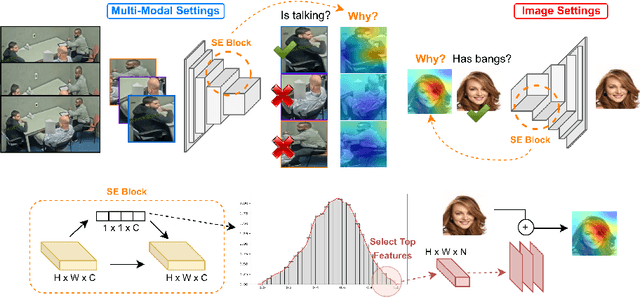
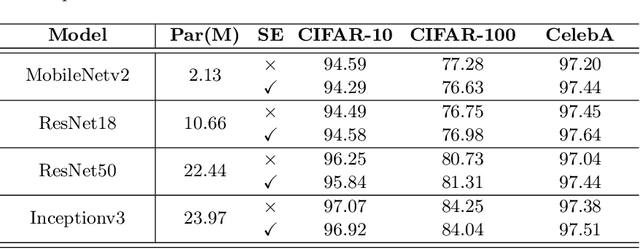


Abstract:Deep learning models are widely used nowadays for their reliability in performing various tasks. However, they do not typically provide the reasoning behind their decision, which is a significant drawback, particularly for more sensitive areas such as biometrics, security and healthcare. The most commonly used approaches to provide interpretability create visual attention heatmaps of regions of interest on an image based on models gradient backpropagation. Although this is a viable approach, current methods are targeted toward image settings and default/standard deep learning models, meaning that they require significant adaptations to work on video/multi-modal settings and custom architectures. This paper proposes an approach for interpretability that is model-agnostic, based on a novel use of the Squeeze and Excitation (SE) block that creates visual attention heatmaps. By including an SE block prior to the classification layer of any model, we are able to retrieve the most influential features via SE vector manipulation, one of the key components of the SE block. Our results show that this new SE-based interpretability can be applied to various models in image and video/multi-modal settings, namely biometrics of facial features with CelebA and behavioral biometrics using Active Speaker Detection datasets. Furthermore, our proposal does not compromise model performance toward the original task, and has competitive results with current interpretability approaches in state-of-the-art object datasets, highlighting its robustness to perform in varying data aside from the biometric context.
BIAS: A Body-based Interpretable Active Speaker Approach
Dec 06, 2024



Abstract:State-of-the-art Active Speaker Detection (ASD) approaches heavily rely on audio and facial features to perform, which is not a sustainable approach in wild scenarios. Although these methods achieve good results in the standard AVA-ActiveSpeaker set, a recent wilder ASD dataset (WASD) showed the limitations of such models and raised the need for new approaches. As such, we propose BIAS, a model that, for the first time, combines audio, face, and body information, to accurately predict active speakers in varying/challenging conditions. Additionally, we design BIAS to provide interpretability by proposing a novel use for Squeeze-and-Excitation blocks, namely in attention heatmaps creation and feature importance assessment. For a full interpretability setup, we annotate an ASD-related actions dataset (ASD-Text) to finetune a ViT-GPT2 for text scene description to complement BIAS interpretability. The results show that BIAS is state-of-the-art in challenging conditions where body-based features are of utmost importance (Columbia, open-settings, and WASD), and yields competitive results in AVA-ActiveSpeaker, where face is more influential than body for ASD. BIAS interpretability also shows the features/aspects more relevant towards ASD prediction in varying settings, making it a strong baseline for further developments in interpretable ASD models, and is available at https://github.com/Tiago-Roxo/BIAS.
A Laplacian-based Quantum Graph Neural Network for Semi-Supervised Learning
Aug 13, 2024



Abstract:Laplacian learning method is a well-established technique in classical graph-based semi-supervised learning, but its potential in the quantum domain remains largely unexplored. This study investigates the performance of the Laplacian-based Quantum Semi-Supervised Learning (QSSL) method across four benchmark datasets -- Iris, Wine, Breast Cancer Wisconsin, and Heart Disease. Further analysis explores the impact of increasing Qubit counts, revealing that adding more Qubits to a quantum system doesn't always improve performance. The effectiveness of additional Qubits depends on the quantum algorithm and how well it matches the dataset. Additionally, we examine the effects of varying entangling layers on entanglement entropy and test accuracy. The performance of Laplacian learning is highly dependent on the number of entangling layers, with optimal configurations varying across different datasets. Typically, moderate levels of entanglement offer the best balance between model complexity and generalization capabilities. These observations highlight the crucial need for precise hyperparameter tuning tailored to each dataset to achieve optimal performance in Laplacian learning methods.
Towards Zero-Shot Interpretable Human Recognition: A 2D-3D Registration Framework
Mar 11, 2024Abstract:Large vision models based in deep learning architectures have been consistently advancing the state-of-the-art in biometric recognition. However, three weaknesses are commonly reported for such kind of approaches: 1) their extreme demands in terms of learning data; 2) the difficulties in generalising between different domains; and 3) the lack of interpretability/explainability, with biometrics being of particular interest, as it is important to provide evidence able to be used for forensics/legal purposes (e.g., in courts). To the best of our knowledge, this paper describes the first recognition framework/strategy that aims at addressing the three weaknesses simultaneously. At first, it relies exclusively in synthetic samples for learning purposes. Instead of requiring a large amount and variety of samples for each subject, the idea is to exclusively enroll a 3D point cloud per identity. Then, using generative strategies, we synthesize a very large (potentially infinite) number of samples, containing all the desired covariates (poses, clothing, distances, perspectives, lighting, occlusions,...). Upon the synthesizing method used, it is possible to adapt precisely to different kind of domains, which accounts for generalization purposes. Such data are then used to learn a model that performs local registration between image pairs, establishing positive correspondences between body parts that are the key, not only to recognition (according to cardinality and distribution), but also to provide an interpretable description of the response (e.g.: "both samples are from the same person, as they have similar facial shape, hair color and legs thickness").
 Add to Chrome
Add to Chrome Add to Firefox
Add to Firefox Add to Edge
Add to Edge